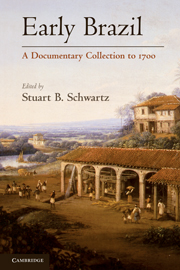Book contents
- Frontmatter
- Contents
- Preface
- A Note on Translation
- A Note on Portuguese Currency, Weights, and Measures
- Maps
- 1 The “Discovery” and First Encounters with Brazil
- 2 The Donatarial System
- 3 Royal Government
- 4 The French Interlude
- 5 Indians, Jesuits, and Colonists
- 6 The World of the Engenhos
- 7 Government and Society in Dutch Brazil
- 8 Burdens of Slavery and Race
- 9 Public and Private Power
- 10 Religion and Society
- 11 Frontiers
- Index
Preface
Published online by Cambridge University Press: 05 June 2012
- Frontmatter
- Contents
- Preface
- A Note on Translation
- A Note on Portuguese Currency, Weights, and Measures
- Maps
- 1 The “Discovery” and First Encounters with Brazil
- 2 The Donatarial System
- 3 Royal Government
- 4 The French Interlude
- 5 Indians, Jesuits, and Colonists
- 6 The World of the Engenhos
- 7 Government and Society in Dutch Brazil
- 8 Burdens of Slavery and Race
- 9 Public and Private Power
- 10 Religion and Society
- 11 Frontiers
- Index
Summary
This collection of documents, many of which are translated here for the first time in English and some of which have not been published before in any language, has been selected to bring to students and general readers basic texts of early Brazilian history. As such, they are part of the broad topic of Europe's expansion in the early modern era and, specifically, of Portugal's role in that process and in the encounter and clash of peoples and cultures that it set in motion. After Vasco da Gama reached India and returned to Portugal in 1498, the way had been opened for trade with Asia by way of the Cape of Good Hope. A second expedition of thirteen ships sailed for India in March 1500 under the command of Pedro Alvares Cabral, but on the outward voyage, its route out into the Atlantic, taken to avoid the contrary winds and currents along the West African coast, brought this fleet to an unexpected landfall on what most (but not all) historians believe was, to Europeans at least, an unknown shore. First contact with the local inhabitants was peaceful; the Portuguese carried out a little trade and exploration; a cross was erected on Friday, the first of May; and a mass was celebrated. The fleet's secretary, Pero Vaz de Caminha penned a report in the form of a letter to the king (I-1) about the new land. A ship was dispatched back to Lisbon, and the remainder of the fleet then proceeded on the Cape route toward India. Cabral called the new land the “Island of the True Cross” but that denomination was soon replaced by “Land of the Holy Cross,” and then in practice by other less spiritual designations. Some of the early mariners referred to this coast as “the “land of parrots,” others called it the “land of the bedsheets” because the white sand of the beaches looked as though sheets had been laid out on the shore, but the most popular name soon became Brazil, a word of debated etymology derived either from the legends of a mystical Atlantic island named “Brasyl” or from the valuable reddish wood that seemed the color of embers (brasas) extracted from the large brazilwood trees that grew in the forests of the new land. In the sixteenth century, in the age of tapestries and before the age of chemical dyes, the color red was particularly hard to produce, and so word of the new Portuguese “discovery” spread rapidly (I-2). Other Europeans, especially French merchants and sailors from Normandy and Brittany, also began to explore the Brazilian coast, contact the indigenous inhabitants, and trade for brazilwood. Despite this competition, the Portuguese crown remained more interested in the spices and riches of India than in a land of naked “gentiles,” parrots, and dyewood.
- Type
- Chapter
- Information
- Early BrazilA Documentary Collection to 1700, pp. ix - xviiiPublisher: Cambridge University PressPrint publication year: 2009

